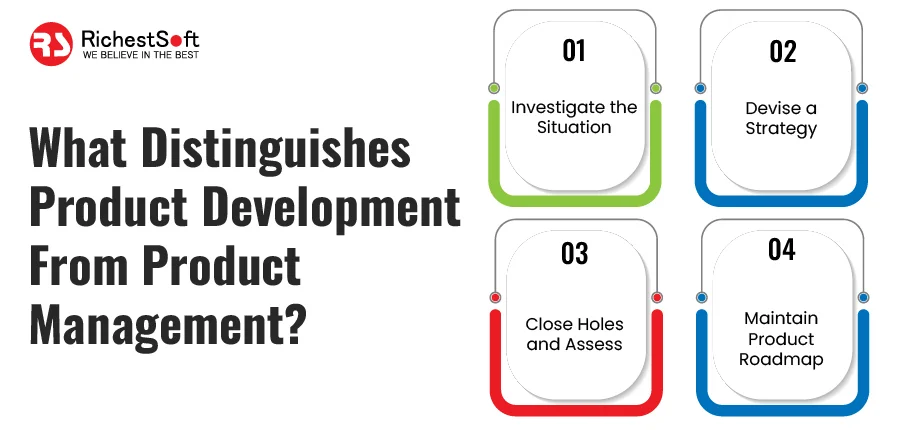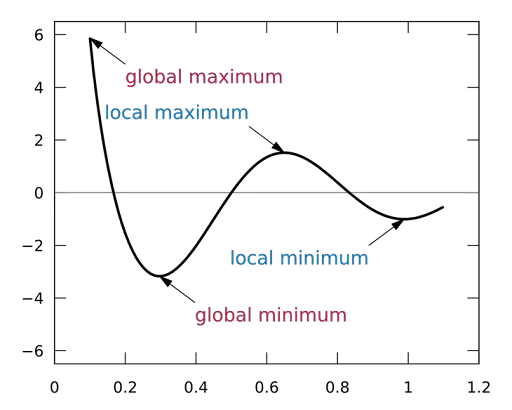Do you want to know how Product development differs from Product management? You are in the right spot, then!
Despite their apparent similarity, product development VS product management are very distinct. Comparing them to a cup and kettle would not be inaccurate because each has a unique purpose. Despite their differences, they are interdependent to survive.
The following lines will examine various facets of these concepts including categorizations, distinctions, and others.
Okay, let’s get going.
What is Product Development?
Getting an idea from a simple concept to a finished product on the market is the entirety of the product creation process.
A product development team comprises experts with engineering and design backgrounds, among other fields.
Along with skilled developers, the team may include talented designers and knowledgeable quality assurance testers who will work together to produce a superior result.
The development teams are given a collection of specifications and must translate those specifications into a usable product. You should be aware that since customer satisfaction is paramount, the product must satisfy the organization’s quality standards.
What is Product Management?
Product management is a strategic position encompassing everything from strategic planning to producing marketing. Its main responsibility, however, remains the same: giving things life.
The composition of a product management team differs from company to company; some have just one product manager, while others have cross-functional teams.
Simply put, the product manager or product management team conducts market and customer research, converts customer wants into requirements, and ensures that the development team complies with these requirements.
What Distinguishes Product Development from Product Management?
Since product development VS product management overlaps significantly, it can be difficult for some people to understand how they vary. Although, a line dividing the two keeps them apart from one another.
- The role of the product manager is to investigate the situation and devise a strategy for achieving the desired outcome, all the while keeping in mind the primary difference. A product manager’s role during roadmap implementation is to close holes and assess whether or not changes are needed.
- Conversely, it is the product development team’s responsibility to see that the product manager’s vision is noticed.
- It must maintain a high-level product roadmap rather than create the product to avoid confusion.
How Does the Process Of Product Development Work?

The process of product development can be both exciting and challenging. From ideation to the market beginning, a product goes through six distinct phases of product development.
Let us get started, then.
✅ Idea generation
The first stage of the product development procedure is idea generation. Customer needs analysis, market research, and, eventually, product concept generation is the purview of the product manager.
When launching a new product concept, many variables are taken into consideration. It consists of your product’s target market, current product portfolio, the general idea of functionality, and strengths and weaknesses.
However, it is best to consider recording the concepts as per a business case, as it will give the team members a clear grasp when validating a product concept.
✅ Product definition
After the business has been finished, and the target market and product functionality have been discussed, it is time to move on to the next step, defining the product.
In this stage, the details, such as the business analysis, value proposition, success metrics, and marketing strategy created by the marketing team, are defined.
After defining each of these concepts, early prototyping and developing a minimum viable product (MVP) can begin.
✅ Prototyping
The product development team will research and document the product by drafting an even more thorough business development plan as you proceed to the prototyping process. Before time, prototypes could be straightforward sketches or sophisticated computer-aided designs.
Before developing the final product, you should use the prototypes to spot potential risk areas. Working on details like a development strategy, an MVP, a market risk analysis, and other related topics will be required.
✅ Initial Design
At this point, the project’s stakeholders collaborate to create a product mockup corresponding to the MVP prototype. The target demographic should always retain in mind during the design process.
Remembering that a working design may undergo multiple modifications before it’s perfect and that sourcing the necessary components may necessitate contacting distributors.
If the customer feedback is unfavorable and the customers’ requirements are not met, changes and revisions to the design will be required.
✅ Testing and Validation
After the original design is finalized, validation and testing must take place. Before the product is made available to the general public, this will guarantee that every component is in good functioning order.
Some tactics to ensure the product’s quality include idea testing and concept development, front-end testing, and market testing.
✅ Commercialization
It will be time for the product launch and commercialization after the testing period. Now, completing the design and evaluating the effectiveness of the marketing and development plan take precedence. You must believe in the last iteration and be prepared to debut the product.
Working on Ecommerce implementation, product development, and having a strong sales staff are all necessary for commercialization to succeed.
What is the Process of Product Management?

Most projects adhere to the 7-step format listed below, although the product management cycle may vary based on the project you work on.
1. Idea Generation
Understandably, developing a product immediately after having a brilliant product concept is appealing. This challenge is that the idea may already exist.
Thus, while brainstorming product ideas is essential, studying the market will save you time.
2. Idea screening
The moment would be right to proceed and specify technical requirements once you have a list of potential product ideas. Its first step would be to choose the top three concepts, then use SWOT analysis to weed out further the most potent and practical concepts.
The basic idea behind this step is to check the concept’s viability and determine whether it makes sense to start working on it.
3. Market and User Research
You might not be aware of this, but lacking a market need is the main factor in any product failure. Therefore, finding the white space by investigating the current goods and market players is particularly important.
When researching the market, it is essential to consider several factors. Some of these factors include the potential for development, the market size being targeted, and the pros and cons of the competition.
Understanding what consumers want and how they prefer to do things is essential for customer research.
4. Strategy Creation
Creating the appropriate strategy aids in realizing the vision for the product, which is formed by market research and consumer development.
A product roadmap is the most effective method to divide the product strategy into actionable steps. Please note that the product roadmap must include company objectives, goals, product areas, priority orders, product features, and key performance indicators (KPIs).
5. Product creation
It is not necessary to debut the product on time. You need to know that effectiveness does not require perfection and that small mistakes are acceptable and feasible.
As a result, you should concentrate on your product’s value and whether it has the features that the customer requires.
6. Evaluation and Feedback Gathering
Setting up a feedback collection mechanism after getting the MVP is crucial. To spot any potential improvements, start by observing how the user interacts with your product and collecting user feedback.
According to a report on product management insights, 60% of product managers believe that the best ideas frequently originate from customers.
Therefore, notice that gathering customer feedback occurs concurrently with product development and that you shouldn’t wait until implementation to consider it.
7. Product Improvement
The product management process is not the goal; you need to maintain your business at this juncture. Once more, efficiency and optimization come into emphasis.
In addition, you should search for methods to expand, enhance operations, maintain business results, and reduce expenses.
How Do Product Development VS Product Management Collaborate?
Product managers and developers must collaborate effectively to produce a high-quality product that satisfies all customer requirements.
Product managers are responsible for creating work standards and a plan that product developers must adhere to. Effective communication is established throughout the endeavor to address a few particular issues.
Which Career Earns the Most Money?
Among product development VS product management senior product developers may earn more than product managers in a competitive market. On the other hand, the compensation of a product manager typically far exceeds that of a product developer. It is because product managers are responsible for marketing and sales.
In addition, it is vitally essential to be aware that product managers have a higher chance of being promoted to director or vice president. These moves typically come with a significant salary increase.
How Does One Become a Product Developer?
The least for entry-level product development positions is completing a bachelor’s degree program. Bachelor’s degrees in food chemistry, marketing, sales, industrial design, or engineering are all viable options for a product developer, depending on the field they hope to enter.
How Does One Become a Product manager?
Select a career route and complete specialized training to become a product manager. By enquiring about other managers in the field, you should gain foundational knowledge and understand the fundamentals of your field moving forward.
You can look into credentials like technical product management certification and product management certification for that. Before the interview, you should finish writing a distinctive resume and developing an elevator speech.
Regarding the skill set needed for product management, you must be proficient in analysis, technical fieldwork, and research and have good communication and research skills.
Most people who work as engineers and coders later become product managers.
FAQs
Q1: Which sectors hire product managers?
Ans: Product managers are employed by a variety of industries to develop and implement novel concepts, including:
- Technology
- Entertainment
- Finance
- Healthcare
Q2: Which sectors hire product developers?
Ans: Product developers are enrolled in various industries, such as
Q3: How does a product manager keep up with the competition?
Ans: The modern product manager’s job is changing due to technological advancements. Prospective product managers will have an edge during hiring if they stay current with technological trends. Technology-related product manager positions rank among the highest paying.
Q4: How does a product developer keep up with the competition?
Ans: It’s crucial to constantly assess current products, search for methods to enhance them and investigate new ways to set them apart from the competition. At last, a product developer must be open to new ideas and ready to take risks to remain competitive.
Q5: Which is the best among Product development vs. Product management?
Ans: It depends on the context because Product Development deals with the actual making of a product, and Product Management is concerned with its overall direction and plan. Moreover, product managers are concerned with discovering what consumers want, while Product Developers work to actualize those desires.
Conclusion
The growth and prosperity of any company depend on both Product development and Product management. Using the above data, you can rank their relative importance. Put a few plans into action and see what comes out. Mastering both will ensure your items make the most money regardless of your path. Evaluate your choices before choosing a career. Knowing your passion makes finding a job easier.







Leave a Reply